I have a 60" TV in my above garage man cave/bar that is mounted on the wall, here's a pic.

The Center channel that's in there now is a Klipsch, I think maybe a G-28 or something. Doesn't really matter as it's not very good. It's thin and fits in the space perfectly, but it sound terrible, sort of like a 1970s mini transistor radio.
So the space is almost 7" from the bottom of the TV to the top of the built in area where the electronics are, and it's 4' wide or so. I can probably get away with 3-4" deep and I can't cut back into the wall because there is a stud behind the center of the area. That stud is actually part of a truss for the structure, so I can't cut into that.
I'm thinking about trying to design a center channel speaker that would replace that klipsch. To prevent comb filtering I am considering just using a single speaker module. The idea would be to build a box in similar shape to the Klipsch so maybe 3" deep, 7" tall, and the length could be anything less than about 40" to accommodate the box volume needed. Could be a sealed box, or if we could get away with it, a ported box maybe with two ports on each side of the center speaker.
For driver choice, I might be able to get away with a 6" driver but it depends on the actual frame size and a few other factors, certainly can do a 5" or 4". I don't think there is anything below 4" that would perform better than the 4" and above drivers. For center channel, maybe there are some 4" offerings that work as well as the larger ones and that would be much easier to construct a box for. Since there is only one driver, power handling is a concern.
Since I will only buy one driver, cost is not an overriding concern but I would like to keep it below $200, although if there was something that was far superior to the rest, maybe I could be convinced. Thus far, I have looked at the following potential driver candidates.
Markaudio - chr90, alpair 10.3, pluvia 11, Pluvia 7HD - The Pluvia 11 looks nice, but it would be a very tight fit, so not sure it would work.
Foxtex - FW108HS, FF165WK, FF125WK, FF105WK. The FF165Wk would also be a very tight fit.
Scanspeak - 10F/8414G-10
Seas - Prestige FU10RB H1600
So, a few questions.
1. Is this just a stupid idea? Maybe I cannot do any better than the Klipsch "70s transistor radio" sound! I sure hope that's not the case.
2. Any opinions on driver selection? Not limited to the ones I have looked at, I'm totally open to any driver.
3. Any opinions on Sealed vs Ported design?
4. Has this idea already been done? I've searched diyaudio but I couldn't find anything. I would have thought this to be a common issue and was surprised I didn't find any other threads, maybe I'm just not good at searching.
Thanks.
The Center channel that's in there now is a Klipsch, I think maybe a G-28 or something. Doesn't really matter as it's not very good. It's thin and fits in the space perfectly, but it sound terrible, sort of like a 1970s mini transistor radio.
So the space is almost 7" from the bottom of the TV to the top of the built in area where the electronics are, and it's 4' wide or so. I can probably get away with 3-4" deep and I can't cut back into the wall because there is a stud behind the center of the area. That stud is actually part of a truss for the structure, so I can't cut into that.
I'm thinking about trying to design a center channel speaker that would replace that klipsch. To prevent comb filtering I am considering just using a single speaker module. The idea would be to build a box in similar shape to the Klipsch so maybe 3" deep, 7" tall, and the length could be anything less than about 40" to accommodate the box volume needed. Could be a sealed box, or if we could get away with it, a ported box maybe with two ports on each side of the center speaker.
For driver choice, I might be able to get away with a 6" driver but it depends on the actual frame size and a few other factors, certainly can do a 5" or 4". I don't think there is anything below 4" that would perform better than the 4" and above drivers. For center channel, maybe there are some 4" offerings that work as well as the larger ones and that would be much easier to construct a box for. Since there is only one driver, power handling is a concern.
Since I will only buy one driver, cost is not an overriding concern but I would like to keep it below $200, although if there was something that was far superior to the rest, maybe I could be convinced. Thus far, I have looked at the following potential driver candidates.
Markaudio - chr90, alpair 10.3, pluvia 11, Pluvia 7HD - The Pluvia 11 looks nice, but it would be a very tight fit, so not sure it would work.
Foxtex - FW108HS, FF165WK, FF125WK, FF105WK. The FF165Wk would also be a very tight fit.
Scanspeak - 10F/8414G-10
Seas - Prestige FU10RB H1600
So, a few questions.
1. Is this just a stupid idea? Maybe I cannot do any better than the Klipsch "70s transistor radio" sound! I sure hope that's not the case.
2. Any opinions on driver selection? Not limited to the ones I have looked at, I'm totally open to any driver.
3. Any opinions on Sealed vs Ported design?
4. Has this idea already been done? I've searched diyaudio but I couldn't find anything. I would have thought this to be a common issue and was surprised I didn't find any other threads, maybe I'm just not good at searching.
Thanks.
8" is the traditional optimum for wide BW speech, musical vocals, so can the frame be recessed to slip in behind the TV, trim work?
You could hack the wall on both sides maybe. Drive two boxes as one actual speaker. Possibly Faital Pro 4"? Comes in 4, 8 and 16 ohm versions. For you budget, you could obtain 4 of them. If you can fettle a port into each, would help loads with the low end.
8" is the traditional optimum for wide BW speech, musical vocals, so can the frame be recessed to slip in behind the TV, trim work?
Thanks, I wish I could do that, but that's just not possible.
You could hack the wall on both sides maybe. Drive two boxes as one actual speaker. Possibly Faital Pro 4"? Comes in 4, 8 and 16 ohm versions. For you budget, you could obtain 4 of them. If you can fettle a port into each, would help loads with the low end.
That's a possible idea, although concerned about comb filtering and off axis issues with 4 drivers.
Well, there's the horizontal Bessel array. A large one worked well a long time ago in a small neighborhood cinema, so maybe a basic 5 or 7 driver one would do well in your app.
A classic MT speaker with a 3” midrange topped by a 1” dome will give you the best vocal range intelligibility for center channel use……you can center that portion over your beam as those drivers will work within you depth restfictions. For flanking woofer duties, use the Dayton LW150 6” low profile woofers……they need only 2” of mounting depth.
A classic MT speaker with a 3” midrange topped by a 1” dome will give you the best vocal range intelligibility for center channel use……you can center that portion over your beam as those drivers will work within you depth restfictions. For flanking woofer duties, use the Dayton LW150 6” low profile woofers……they need only 2” of mounting depth.
That's a nice idea. For now I have purchased a Pluvia 7 HD to do some experimenting with. If it doesn't work for a center channel, I can always buy another one and make a pair as there are a few designs I've wanted to try anyway.
I'll post updates here as I get started with it. I'm not in a hurry so it might take a while.
gabo
The problem with that solution is the off axis response for a single driver that large will be difficult for anyone 30 degrees off or more. But if your seating falls within 30 degrees, you’ll be ok with the Pluvia 7. Voice intelligibility becomes critical particularly with today’s multi channel mixes where so much location info is mixed into the CC.....about 75% of content from a modern 5. Soundtrack emanates here. You can certainly test it simply with a mock up enclosure and then just watch a dynamic movie with only the center channel on.......you’ll know by then of the show if it’s gonna for the bill.
Now your mains look pretty serious and if there’s any intense volume use for movies (100db transient peaks), that little Mark driver is gonna suffer badly even with a 100hz high pass......it’s gonna need low end support. A pair of those LW150’s even mounted in a shallow sealed enclosure would get the job done if you can give them .5 cuft between the pair......crossover could be a simple 1st order around 400hz.
Now your mains look pretty serious and if there’s any intense volume use for movies (100db transient peaks), that little Mark driver is gonna suffer badly even with a 100hz high pass......it’s gonna need low end support. A pair of those LW150’s even mounted in a shallow sealed enclosure would get the job done if you can give them .5 cuft between the pair......crossover could be a simple 1st order around 400hz.
Yep, all concerns of mine as well. I've always known this was a bit of a long shot to accomplish. But it's a combination of needing something better and wanting to play with some of these full-range speakers. And they do solve some traditional problems, especially with MTM designs as many of them are terrible off axis. So I'm trading the typical MTM problems with lobing and comb filtering for potential problems with narrow beaming from a single full range. Then I also have the mounting problems and depth issues.
All this actually makes it fun as it is a challenge to deal with all the problems. It may take me a while, but I'll come up with something that works at least better than what I have.
All this actually makes it fun as it is a challenge to deal with all the problems. It may take me a while, but I'll come up with something that works at least better than what I have.
I received my Pluvia 7HD driver, did a bit of break in, measured the T/S parameters and proceeded to design a test box for it. After measuring and thinking about everything, it just wasn't possible to build anything flat enough. The Pluvia is a fairly deep driver for a small 4" so the thinnest I could possibly get a box was about 3 1/2" and that would have put the back of the driver right up against the back of the speaker box, and of course made it next to impossible to get a good sound.
Here is a pic of the measured T/S parameters and the impedance.
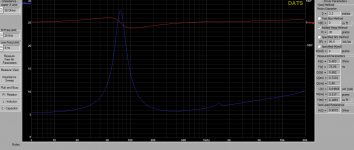
In looking at my space, I decided to cut out the sheetrock on either side of the center stud and build two boxes. If I did that, the boxes could also be used as small stereo speakers should they not work out as well as I hoped for center channel use. Instead of purchasing the 2nd Pluvia, I just wanted to build the first one as a test to see how it sounds and to test fit it into the hole.
The room is a rustic room and I had a piece of barn wood in my shop that was perfect (enough left over for the 2nd box too). Since the rest of the box will be hidden behind the wall, it can be built out of anything. Again, I had scraps in my shop I could use.
In designing the box, it turned out that a standard bass reflex box could be built with a port that was only the thickness of the front panel, so I didn't need to put a port tube in it. Here is a pic of the box and inside before I added stuffing, which is just a bit of polyfill.
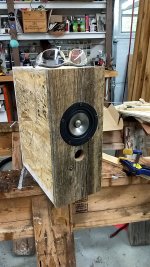
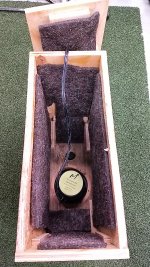
After assembly I took some measurements. Here is a frequency response graph with psychoacoustic smoothing. This is the straight measurement without windowing in my shop.
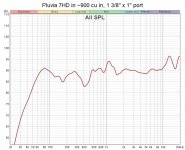
and a frequency response from the close measurement + the port measurement + the in room measurement above 800hz.
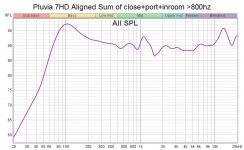
Fairly close to design parameters, you can see the baffle effects around 1K in both graphs, the rest looks pretty much like the models predicted. Since I'm going to mount this flush to the wall the baffle step will largely be diminished. The dip after the baffle step, which is around 1.6Khz, and the peak at around 13K are both similar to the published graph from MarkAudio.
Subjective listening to the speaker, it's pretty good. You can hear the 1Khz peak a bit, the 13Khz peak is not noticeable for old guys like me 🙂 The low frequency hump provides a pretty good "room curve" so it's quite pleasant to listen to.
For off axis performance, which is key in my use of it as a center channel, I did the measurements with the speaker on it's side as that's the orientation for center channel use. Here is a graph of 0 degrees, 15 degrees, and 30 degrees.

This is a bit disappointing. I need to go back and remeasure to make sure something wasn't amiss with the 30 degree measurement. That big dip at 13K probably won't hurt the center channel too much as it's focused on voice. But the drop from 2.5K to 10K is much more concerning.
Overall listening and comments.
With a bit of DSP tweaking it could be quite nice at least on-axis. It doesn't have the smoothness in the higher frequencies of some two way speakers I have, but at the price point, it's excellent. The driver was just under $50, the materials were all scraps I had on hand, shipping and connectors all total I have around $65 in this speaker. So from a cost perspective it's dirt cheap. So with that in mind, I will purchase a 2nd driver and build the other speaker so I have a pair.
As for usage for my center channel, the jury is still out. The off axis response when turned on it's side is certainly not optimal. I do need to remeasure that to make sure I did that correctly. When I get the 2nd one built, it will also be interesting to see what sort of comb filtering/interaction I get between two of them separated by about 8 inches, as that would be optimal in my wall. In my wall, I can also turn each speaker to the outside (R speaker turned right, L speaker turned left) just slightly. It winds up being turned the width of the front baffle, the outside of the baffle is flush with the wall, the inside is like it's mounted on top of the sheetrock. This would help the overall off axis response in the room as people sitting R/L would get center channel sound from a speaker that is not much off axis, probably within the 15 degree range. Turning them also might help the comb filtering between the two units, actually the lack of off-axis response from the speakers would tend to reduce the comb filtering.
So once I get the the other one built, I can do some testing to see if I want to use them for my center channel speakers or give them to someone who could use them for small speakers. Stay tuned as I'll post again when I finish the 2nd one and see how things turn out.
Here is a pic of the measured T/S parameters and the impedance.

In looking at my space, I decided to cut out the sheetrock on either side of the center stud and build two boxes. If I did that, the boxes could also be used as small stereo speakers should they not work out as well as I hoped for center channel use. Instead of purchasing the 2nd Pluvia, I just wanted to build the first one as a test to see how it sounds and to test fit it into the hole.
The room is a rustic room and I had a piece of barn wood in my shop that was perfect (enough left over for the 2nd box too). Since the rest of the box will be hidden behind the wall, it can be built out of anything. Again, I had scraps in my shop I could use.
In designing the box, it turned out that a standard bass reflex box could be built with a port that was only the thickness of the front panel, so I didn't need to put a port tube in it. Here is a pic of the box and inside before I added stuffing, which is just a bit of polyfill.


After assembly I took some measurements. Here is a frequency response graph with psychoacoustic smoothing. This is the straight measurement without windowing in my shop.

and a frequency response from the close measurement + the port measurement + the in room measurement above 800hz.

Fairly close to design parameters, you can see the baffle effects around 1K in both graphs, the rest looks pretty much like the models predicted. Since I'm going to mount this flush to the wall the baffle step will largely be diminished. The dip after the baffle step, which is around 1.6Khz, and the peak at around 13K are both similar to the published graph from MarkAudio.
Subjective listening to the speaker, it's pretty good. You can hear the 1Khz peak a bit, the 13Khz peak is not noticeable for old guys like me 🙂 The low frequency hump provides a pretty good "room curve" so it's quite pleasant to listen to.
For off axis performance, which is key in my use of it as a center channel, I did the measurements with the speaker on it's side as that's the orientation for center channel use. Here is a graph of 0 degrees, 15 degrees, and 30 degrees.

This is a bit disappointing. I need to go back and remeasure to make sure something wasn't amiss with the 30 degree measurement. That big dip at 13K probably won't hurt the center channel too much as it's focused on voice. But the drop from 2.5K to 10K is much more concerning.
Overall listening and comments.
With a bit of DSP tweaking it could be quite nice at least on-axis. It doesn't have the smoothness in the higher frequencies of some two way speakers I have, but at the price point, it's excellent. The driver was just under $50, the materials were all scraps I had on hand, shipping and connectors all total I have around $65 in this speaker. So from a cost perspective it's dirt cheap. So with that in mind, I will purchase a 2nd driver and build the other speaker so I have a pair.
As for usage for my center channel, the jury is still out. The off axis response when turned on it's side is certainly not optimal. I do need to remeasure that to make sure I did that correctly. When I get the 2nd one built, it will also be interesting to see what sort of comb filtering/interaction I get between two of them separated by about 8 inches, as that would be optimal in my wall. In my wall, I can also turn each speaker to the outside (R speaker turned right, L speaker turned left) just slightly. It winds up being turned the width of the front baffle, the outside of the baffle is flush with the wall, the inside is like it's mounted on top of the sheetrock. This would help the overall off axis response in the room as people sitting R/L would get center channel sound from a speaker that is not much off axis, probably within the 15 degree range. Turning them also might help the comb filtering between the two units, actually the lack of off-axis response from the speakers would tend to reduce the comb filtering.
So once I get the the other one built, I can do some testing to see if I want to use them for my center channel speakers or give them to someone who could use them for small speakers. Stay tuned as I'll post again when I finish the 2nd one and see how things turn out.
Last edited:
Hello Gbowling, reaching out to see if you got around to building the second one and what were your overall findings.
Kind of in the same boat trying to understand if they work well as center channels. Got the drivers, yet to build the boxes.
Thanks and hope you are well.
Kind of in the same boat trying to understand if they work well as center channels. Got the drivers, yet to build the boxes.
Thanks and hope you are well.
I did build a second one. They are really not that great for center channel speakers, much to my disappointment. They really sound pretty good as bookshelf speakers, especially for the price point. And due to not having the complexity of crossover design, speaker alignment, component matching, etc., they are dead simple as a DIY build as well.
But for center channel, not as good. I get some phase cancelling from the speakers being close together causing some dead zones in coverage. Actually with both of them in place, the worst sound is when sitting absolutely in the center of the room, they cancel either other quite a bit there. But that's actually not bad because with multiple people in my room, there is almost never anyone sitting directly in front. By the way, this is also a big problem in general with commercial center speakers. Many of the designs with multiple speakers have this issue.
I might be a bit harsh on my review. If you get people sitting in the right places, they do sound quite good. And fortunately my chairs in my room are in good spots. But if I had purchased commercial speakers with the amount of phase cancelling I get, I would be disappointed. They look really cool in my space, with the barnwood boxes, and they are usable for now so I've kept them in place. But they aren't as good as I had hoped.
Maybe some day I'll try another build for my center channels and use these as a bookshelf.
But for center channel, not as good. I get some phase cancelling from the speakers being close together causing some dead zones in coverage. Actually with both of them in place, the worst sound is when sitting absolutely in the center of the room, they cancel either other quite a bit there. But that's actually not bad because with multiple people in my room, there is almost never anyone sitting directly in front. By the way, this is also a big problem in general with commercial center speakers. Many of the designs with multiple speakers have this issue.
I might be a bit harsh on my review. If you get people sitting in the right places, they do sound quite good. And fortunately my chairs in my room are in good spots. But if I had purchased commercial speakers with the amount of phase cancelling I get, I would be disappointed. They look really cool in my space, with the barnwood boxes, and they are usable for now so I've kept them in place. But they aren't as good as I had hoped.
Maybe some day I'll try another build for my center channels and use these as a bookshelf.
Thank you very much for the helpful and quick reply!! I'll maybe try a single larger Mark audio driver. But first I'll build the smaller bookshelves and see how that goes.
But I agree with you that most center channels have that effect and for diy without crossovers this is easy to work around with.
But I agree with you that most center channels have that effect and for diy without crossovers this is easy to work around with.
So, what exactly do you have for the front 3 speakers ?
And you are trying for coverage for a stereo and/or theater setup ?
To me, a pluvia 7 is basically just under a 4" driver, so aimed at the middle of a couch, highs should cover 7' wide max.
I'm remembering couch wide at 7' or 10' when I had an array of w4-1337sdf's, can't remember.
I've had 4 x 3" vertical array that worked amazingly (for what it was), as did an 8" full range for voice work and light bass.
Each had their own issues that came with the design, no surprises there.
But I am baffled how yours' are cancelling each other out......
Maybe if your center channel is playing in mono (blended) during a stereo recording, it could be cancelling out when you move out of the sweet spot....
And you are trying for coverage for a stereo and/or theater setup ?
To me, a pluvia 7 is basically just under a 4" driver, so aimed at the middle of a couch, highs should cover 7' wide max.
I'm remembering couch wide at 7' or 10' when I had an array of w4-1337sdf's, can't remember.
I've had 4 x 3" vertical array that worked amazingly (for what it was), as did an 8" full range for voice work and light bass.
Each had their own issues that came with the design, no surprises there.
But I am baffled how yours' are cancelling each other out......
Maybe if your center channel is playing in mono (blended) during a stereo recording, it could be cancelling out when you move out of the sweet spot....
Yea, I have serious space issues as discussed in the first post, so all the "8" fill range options" just won't work. It's not a big deal at the moment.
I'm getting phase cancellations because I have two pluvia's installed under my TV. The drivers are fairly close together, so they interact with each other. Really easy to hear.
My issue is that I have a post in the center, which is a truss for the building, so it can't be moved or cut. So I have two speakers sunk in the wall either side of the truss beam. All this has to fit in about a 5" vertical space and be flush to the wall.
It's all good, I'm using these for a bit and I'll eventually find time to work on it again and do something else.
I'm getting phase cancellations because I have two pluvia's installed under my TV. The drivers are fairly close together, so they interact with each other. Really easy to hear.
My issue is that I have a post in the center, which is a truss for the building, so it can't be moved or cut. So I have two speakers sunk in the wall either side of the truss beam. All this has to fit in about a 5" vertical space and be flush to the wall.
It's all good, I'm using these for a bit and I'll eventually find time to work on it again and do something else.
Ahhhhhh.
So you have 2 x 4" drivers side by side, and they aren't touching frame to frame.......
Yea, that's massive trouble if not sitting exactly between them.
You could disconnect 1 of them...
That would work fine assuming you are running it as a "small" speaker.
So you have 2 x 4" drivers side by side, and they aren't touching frame to frame.......
Yea, that's massive trouble if not sitting exactly between them.
You could disconnect 1 of them...
That would work fine assuming you are running it as a "small" speaker.
- Home
- Loudspeakers
- Full Range
- Single Speaker Flat Wall Mount Center Channel